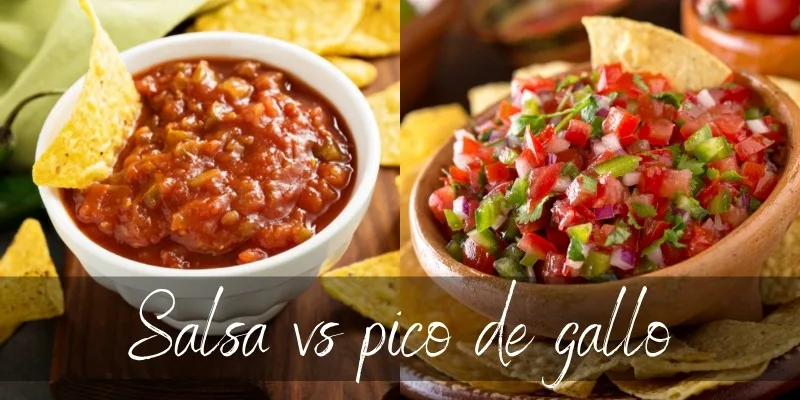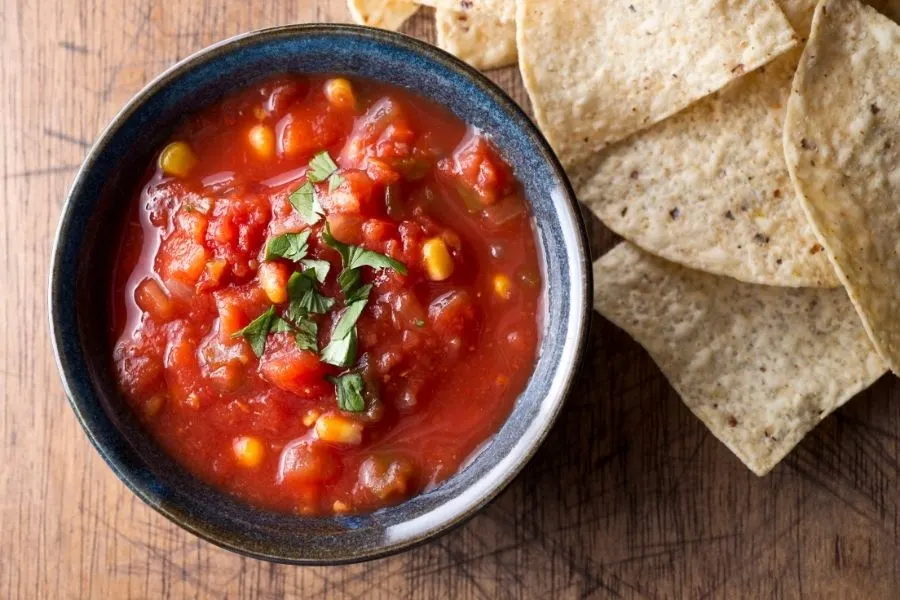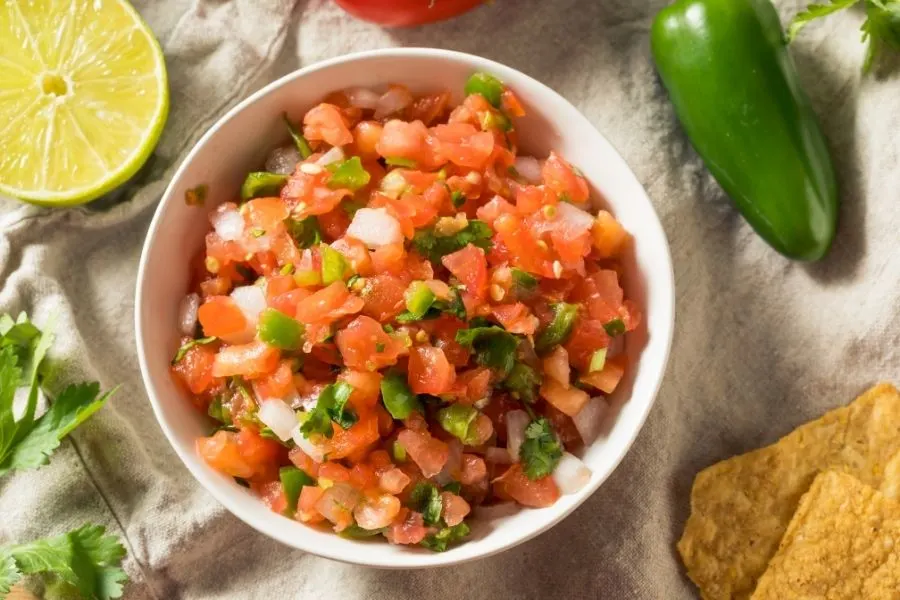If you’re having a Mexican-themed lunch or dinner, you’re likely debating whether to go for the better-known salsa, or try out pico de gallo. Most people have heard of or have had some form of salsa, but many are unfamiliar with pico de gallo and thus may be unsure which would pair best with dinner.
So, this is what we’re going to take a look at today. What salsa is, what pico de gallo is, and how the two differ (or are alike). By their names you wouldn’t guess they’re in any way related but in fact they’re very close cousins.

Pico de gallo vs salsa
Pico de gallo is a fresh-ingredient salad consisting of finely chopped tomatoes, onions, jalapenos, cilantro, and lime juice. Salsa is a much more vague term, but it usually describes the same ingredients as in pico de gallo, but with a more liquid consistency.
Salsa is versatile in that it may be raw or cooked, spicy or not, and it’s still considered a salsa. Pico de gallo is never as soupy as salsa, and has a specific set of ingredients. Salsa can be made of many other ingredients, sometimes swapping tomatoes for tomatillos or avocados.
Both are delicious Mexican condiments and you can easily use them in whatever you’re cooking. Due to pico de gallo’s texture it works great as a taco filling, in a burrito, used as a base for a salad, or even served with nachos in place of salsa.
What is salsa ?
Salsa is a traditional Mexican sauce, however it has slightly different meaning in America and Mexico. In Mexico salsa refers to almost any sauce, cooked or raw, spicy or not. It may or may not have tomatoes and onions in it.

In America salsa usually refers to red salsa, the one with tomatoes, onions, peppers, and cilantro all roughly chopped and possibly cooked together. This is because when salsa became commonplace in America, it was canned salsa, and it was always cooked to preserve its shelf life.
Read also: Tomato Sauce VS Ketchup
The word ‘salsa’ means ‘sauce’ in Spanish, and because of this, it can refer to many other sauces aside from the typical cooked red tomato sauce. You can find avocado-based salsa that may be easily confused with guacamole, you can find salsa verde which does not use tomatoes but tomatillos, and you can find completely raw, uncooked salsa.
What is pico de gallo ?
Pico de gallo usually consists of tomatoes, onions, jalapenos, and fresh cilantro, all finely chopped and tossed with salt and lime juice. It’s more of a fresh salsa than a sauce, and it relies on the freshness of the ingredients. Pico de gallo from a can simply does not taste right.
Pico de gallo means ‘rooster’s beak’ in Spanish, for various reasons. Some say it’s because of the way pico de gallo was eaten – pinched between fingers, like a bird beak. Some say it’s because it’s so finely chopped it resembles bird feed.
Whatever the reason for tis name, picoi de gallo is always finely chopped and you can clearly see each ingredient. It’s not soupy and it’s not a liquid, rather it’s chunky. There is a bit of juice from the tomatoes, though that’s not the main focus of the dish.
Pico de gallo is always fresh
Because of the way pico de gallo works, it’s always going to be fresh. Pico de gallo relies heavily on the freshness of the ingredients, so it will always be uncooked. Unlike fresh salsa, pico de galo is finely chopped. Fresh salsa is often mashed with a mortar and pestle, but left raw. There is a difference in texture.
The most common version of salsa is the cooked versions, because it is easily canned and stores for a long time. Because it’s cooked, salsa is always going to taste different from pico de gallo. Generally the more you simmer a toamto sauce – like salsa – the more to take the edge off the acidity.
Meaning that if you know you have an issue with fresh tomatoes and onions, a properly made salsa will be better for you than pico de gallo.

Salsa comes in many versions
Because salsa is a very vague term – it just means sauce – it can take many forms. The most common one is tomato and onion-based, yes, but it’s not the only kind of salsa you will find.
Salsa verde does not use tomatoes at all, but instead uses smaller tomato-like berries that remain green and give the sauce a green look. They also taste different.
Another kind of salsa verde is actually a modified guacamole, with a lot of avocado and almost no tomatoes. It may have another tomatillos or just finely chopped green peppers in it. After all the name ‘verde’ translated to green to a green salsa can be anything that is green.
You can also get raw salsa, which opens up a whole new door for what kind of sauce to make, as long as you leave the ingredients raw.
Pico de gallo is chunky and less liquid than salsa
A key point in salsa, raw or cooked, is its consistency. It’s always a soupy or saucy affair, and it’s never overly chunky. Even fresh red salsa has most of its ingredients chopped and then blended.
Pico de gallo is much more dry by comparison. There is some moisture and liquid, but it’s at the bottom of the bowl and it’s likely just tomato juice and lime juice. You can strain it if you want, and only have the ingredients.
Both pico de gallo and salsa can easily be used as a sauce or dip
Because of their texture both pico de gallo and salsa can be sued as a dip or sauce. For example with nachos you can easily scoop some pico de gallo with the nacho and eat it as-is. Or you can dip the nacho into some salsa, fresh or not.
The point is you can use salsa and pico de gallo interchangeably, especially if they have similar ingredients. And you can use both of them as filling or sauce for a taco or burrito without issue.
Both salsa and pico de gallo can be spicy
Since both salsa and pico de gallo call for jalapenos (or any other hot pepper) they can both be spicy. How spicy they are depends on how much of the pepper you decide to add, whether to include the seeds or not, and which peppers you use. As you know, some peppers rate higher on the Scoville scale.
And you can omit hot peppers from salsa and pico de gallo without issue. But you may have to add a bit of bell pepper instead, simply for the flavor. If you do use bell peppers, remember that green bell peppers are much more bitter than green jalapenos.

